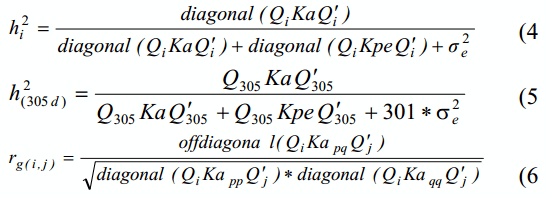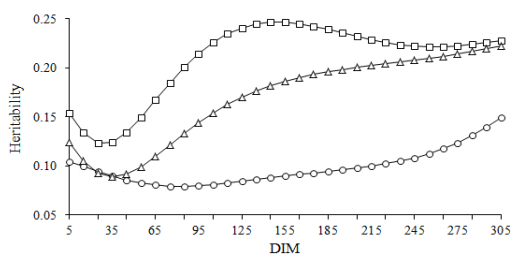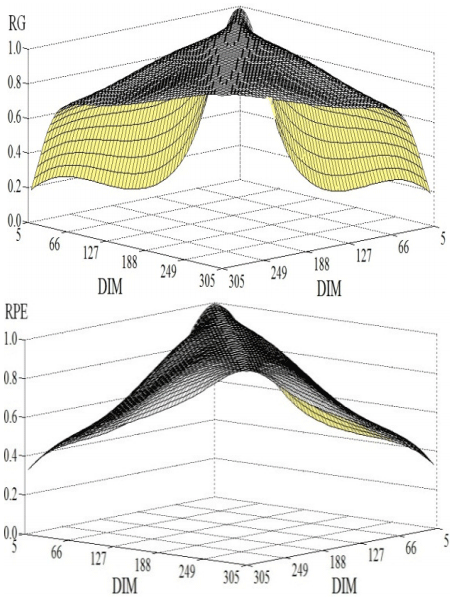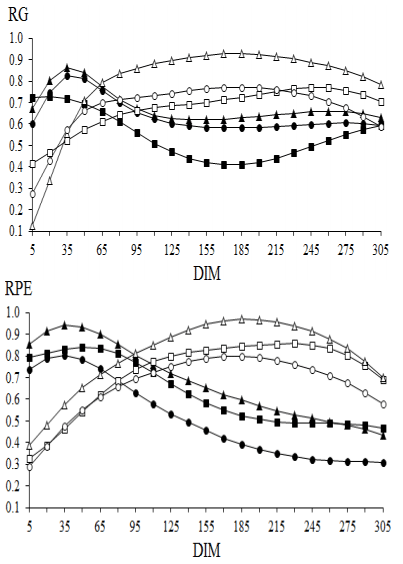Introduction
Nowadays production of dairy cattle has become a sophisticated money-making industry throughout the world. For many producers, production traits, e.g. milk, fat and protein yield still form the cornerstone of many breeding plans. In general, no breeding plan could be sustained without genetically addressing and exploring these traits. A recent study indicated that, milk yield per cow per lactation has become more than doubled in the last 40 years (Oltenacu and Broom, 2010). Prediction breeding values constitute the main part of most breeding plans. In order to predicting breeding values, genetic parameters of traits should be known. These genetic parameters can be estimated (since their real values are unknown) using suitable breeding designs and statistical models. In recent years, Test Day (TD) models received lots of attention to evaluate genetic potential of dairy cattle by many breeders and researchers around the world (Pool et al., 2000; Swalve, 2000). This method of genetic evaluation is almost grasped worldwide instead of classical 305 day based genetic evaluation. Test day model has some advantages in respect to 305 day based method, amongst them are: computation and considering environmental factors that could affect the performance of cows throughout the lactation (Ptak and Schaeffer, 1993), increasing accuracy of genetic evaluation due to increasing the volume of data per animal (Carvalheira et al., 1998), lack of need to extend uncompleted milking period and reducing the cost of recording (Bilal and Khan, 2009).
Various TD models have been recommended for genetic evaluation of dairy cattle (Swalve, 2000). Among the models that consider TD records, random regression model (RRM) has been widely shown to increase the accuracy of breeding value predictions in many countries (Strabel et al., 2004). Mathematical solid foundation of RRM and its application in current evaluation of dairy cattle and other species throughout the world is doubtless. The use of RRM makes it possible to study changes in TD records over time and a better understanding of lactation genetics (Swalve and Guo, 1999). Therefore, at the present, the random regression TD model is referred to be the most precise model for estimation of production traits in dairy cattle (Lidauer and Mäntysaari, 1999).
Though, applying animal model to evaluate Iranian Holstein dairy cattle production traits goes back to 1994 (Safi Jahanshahi et al., 2003). There have been scant studies in which multiple-trait RRM has been adopted. Due to this fact, the objective of the current study was to predict production traits genetic parameters in Iranian Holstein dairy cattle using multiple-trait random regression animal model (MT-RRAM).
Materials and Methods
Data collection
In this study, records of milk production, protein and fat yield of Iranian Holstein dairy cattle during 2005 to 2010 in Iran Breeding Centre, located in Karaj, Iran was used. In order to edit and explore fixed effects on each trait, GLM procedure of SAS (Version 9.1, 2003) was used. All records spanned between 5 to 305 days of milk (DIM) belong to cows having age 22 to 33 month and their milk yield, fat and protein percentage were in the range of 2 to 48 kg, 1.5 to 9% and 1 to 7%, respectively. Cows were assigned to one of the three subclasses of age at calving (<26, 26-30 and >30 months) and to one of four seasons of calving (spring, summer, fall and winter). In order to increase accuracy of prediction, records of those animals which possess at least 8 records for all traits (to get rid of missing values) and their first record was registered before first 60 DIM. In order to maximum application of the covariance among animals, a big pedigree file spanned 1990–2010 was used. Finally, a data file contained 30729 daughters with 276962 records, gathered over 79 herds. Pedigree file included 691 sires and 26042 dams (Table 1).
Statistical genetic analysis
Multiple-trait random regression animal model was fitted to data in REMLF90 (Misztal et al., 2002) program and Restricted Maximum Likelihood (REML) method was adopted to estimate the parameters. In this research, for milk and protein yield three order (4 covariates) of Legendre polynomial (Kirkpatrick and Heckman, 1989) was adopted but for fat yield Lidauer-Mäntysaari (1999) function (LM) was used. Finally, the model equation was:
Where yjklmr is the observation of rth trait; ycj is the fixed effect of jth year of calving; htdk is the fixed effect of kth herd-test-day; Sln is the nth fixed regression coefficient specific to age-season subclass l; amn is the nth random regression coefficient of additive genetic effect of cow m; pemn is the nth random regression coefficient of permanent environmental effect of cow m; Qnr(t) is the nth coefficient (constant, quadratic, cubic, quartic) of Legendre polynomials matrix or LM evaluated at DIM t; and ejklmr is the random residual effect.
In matrix notation, the following random regression model was fitted:
b = a vector of fixed effects; s = a vector of fixed regression coefficients; a = a vector of random regression coefficients (RRC) for animal genetic (AG) effect; pe = a vector of RRC for permanent environmental (PE) effect; e = a vector of residual effects; W, Z, and X = incidence matrices relating observation to respective effects.
Also it was assumed that random effects had following (co)variance structure:
Where G = Relationship matrix across all animals; Ka and Kpe = a 12 by 12 covariance matrices of RRC for additive genetic and permanent environmental effects, respectively; R = a 3 by 3 diagonal matrix of residual variances; I = the identity matrix and, ⊕ depicts the Kronecker product operator. Based upon predicted (co) variance components, heritability (as function of DIM 305 day) for all traits and also genetic correlation among traits obtained using following formula (Jakobsen et al., 2002):
Kapq indicates a matrix of additive genetic (co)variances between traits p and q. Note that i=j if observations were on the same day, and i≠j if observations were on different days (Jakobsen et al., 2002).
Table 1: Description of data set used for estimation of variance components
Results and Discussion
Fixed effects
In general, the average of milk, fat and protein yields were 31.5, 1.063 and 0.958, respectively. Over the period considered, milk yield showed a consistent decline. The year of calving solution for 2005 was 0.59, it became 0.00 in 2008 and finally in 2010 it obtained -0.87. Even though these values for fat yield (from 0.85 to 0.81) and protein yield (from 0.77 to 0.76) were positive, but they fairly showed a reducing trend. About the effect of age-season of parturition, as it is expected, it was observed that with increasing age of animal in parturition, though negligible, but continuously these values showed an increasing trend. For instance, predicted milk yield for different classes/categorizations of age of parturition, were 32.07, 32.59 and 33.20, respectively.
Genetic parameters
Heritabilities and variances
Results of this study indicated that predicted genetic variances during lactation period increased at the end of lactation period. In comparing the trend of predicted genetic variances for all traits, it was observed that similar to their phenotypic trend (results not reported), milk and protein yield traits had higher similarity than fat yield trait in terms of their genetic variances trend. Concerning to predicted environmental variances for all production traits in this study like trend were observed in such a way that the minimum and maximum values for this components were observed at the middle and beginning of lactation period, respectively (results not reported). Such trend has been reported for Tunisian and Marco Holstein dairy cattle (Hammami et al., 2008; Tijani et al., 2010) which are in agreement with our results.
Heritabilities of milk production traits as a function of DIM are shown in Figure 1. The heritabilities of milk, fat and protein yields as a function of DIM were estimated between 0.12 to 0.25, 0.08 to 0.15 and 0.09 to 0.22, respectively. Previous estimates of heritability of milk yield [fat and protein yields] in Iran were 0.09 to 0.23 [0.06 to 0.12 and 0.07 to 0.23] with a multiple-trait random regression sire model (Bohlouli and Alijani, 2012). Heritability for milk yield assessed by Penasa et al. (2010) in the Italian dairy cattle was 0.09 to 0.28. For milk and protein yields, there are higher heritability estimates than for fat yield based on DIM, which are in accordance with many other similar investigations (Strabel et al., 2004; Zavadilová et al., 2005; Hammami et al., 2008). For all traits, predicted heritabilites over 20 to 35 DIM obtained downwardly which could be due to high amount of permanent environmental variance over this period; however, predicted genetic variances for fat trait with a little discrepancy was identical to protein yield (Table 2). The difference between fat and protein in terms of predicted environmental effect was obvious which culminated in having low amount of heritability for fat trait in comparison with protein trait. In general, predicted heritabilities and genetic variances for fat yield and protein yield showed similar trend, in such a way that their maxim values for both traits can be seen at the end of lactation period. In case of milk yield, the maximum values of predicted heritability and genetic variance observed in middle of lactation (140 to 150 DIM), which showed a declining trend over course of DIM and it became almost relatively constant at the end of lactation period. For milk yield, the main reason for this trend of change of genetic variance, could be due to sharply reduction of permanent environmental effect which itself can be as a function of animal adaptation.
The range of predicted heritability for total milk production across different literatures have been diverse e.g. 0.14 (Strabel et al., 2004) to 0.55 (De Roos et al., 2001). In this study, these values for milk, fat, and protein yields (0.32, 0.32, and 0.33) were slightly higher than the results obtained with a multivariate model (Razmkabir, 2005) on the same population used for this study. Our results were comparable with 0.30, 0.27, and 0.28 obtained by Muir et al. (2007) in Italian Holsteins using multi-lactation RRM. However, heritabilities of yield traits for the Iranian Holsteins were larger than those reported in Tunisian Holsteins (Hammami et al., 2008) and Polish Black and White cattle (Strabel and Jamrozik, 2006).
Genetic correlations
Within traits
So far many studies have pointed out lacking consistency among days over lactation period (Jakobsen et al., 2002; Zavadilová et al., 2005; Hammami et al., 2008). Based upon the results of Table 3, the maximum genetic and permanent environmental correlations observed for consecutive days (close to unity). These results are in agreement with other studies (Jakobsen et al., 2002; Zavadilová et al., 2005). However, the magnitude of these variations was different across traits. For example, genetic correlation between 5 and 305 days of lactation period for milk yield and fat yield predicted 0.19 and 0.27 respectively, whereas, for protein yield genetic correlation for the same period (5 and 305 DIM) predicted 0.64, almost 3 times of value predicted for milk yield (the data are not presented). In general, the association between TD records in relation with increasing the interval between DIM is not linear. For example in the case of milk yield, it is observed that with increasing the interval between DIM, the amount of genetic correlation reduced in such a way that for DIM 130 and 140 the minimum value (0.1) turned out, but around 280 DIM, it gradually increased (0.23) and again at end of lactation period a reduction trend was observed (Fig. 2). However, Jamrozik and Schaeffer (1997) and Rekaya et al. (1999) observed negative correlations for extreme parts of the lactation when working with random regressions. The correlation between permanent environmental effects decreased much faster than additive genetic effects as TD got further apart (Table 3).
Table 2: Estimates of variance components and heritability for daily milk yields on selected days in milk (DIM) and 305-day milk, fat and protein yields
Table 3: Genetic (above diagonal) and permanent environmental (below diagonal) correlations (×102 ) on selected days for milk, fat and protein yields
Table 4: Heritability (on the diagonal), genetic (above diagonal), and permanent environmental (below diagonal) correlations for 305-d milk, fat, and protein yields
Fig. 1: Heritability estimates of test-day milk (squares), protein (triangles), and fat (circles) yields
Fig. 2: Genetic (RG) and permanent environmental (RPE) correlations between test-day milk yield at different stages of lactation
Fig. 3: Additive genetic (RG) and permanent environmental (RPE) correlations between a given DIM* and the remaining part of lactation between milk and fat yield (squares), milk and protein yield (triangles), and fat and protein yield (circles). *DIM: 35 (solid), and 185 (open)
About all traits, like genetic correlations, predicted environmental correlation obtained positive (>0.2) value. Exception for fat yield, predicted environmental correlation for other traits obtained higher values than their corresponding genetic correlation for the same interval of DIM. This point should be taken into account in running secure sustainable breeding plans.
Between traits
The results of prediction of genetic and permanent environmental correlations among traits across different days of lactation period are presented in Table 3. The genetic correlation between milk yield with fat and protein yields ranged from 0.01 (for 5 and 170 DIM) to 0.85 (for the end of lactation) and 0.06 (5 and 140 DIM) to 0.93 (for the end of lactation), respectively. Range of these values concerning correlation between fat and protein yield showed a bit constant trend (0.27 to 0.90). Overall, the maximum genetic correlation between traits was observed for similar DIM and increased toward the end of lactation. High genetic correlations between adjacent test days imply that any both traits are influenced by similar genes (Ilatsia et al., 2007).
The ranges of genetic and environmental correlations among traits for whole lactation period (305 day) were 0.76 to 0.93 and 0.87 to 0.97, respectively (Table 4). In agreement with other researches (Jakobsen et al., 2002; Zavadilová et al., 2005; Hammami et al., 2008) the maximum value belonged to the amount of milk and protein yields and the minimum value belonged to milk and fat yields. About permanent environmental correlation (Table 3), the maximum and minimum values observed for milk and protein yields and milk and fat yields, respectively. This parameter predicted positive and in concordance with genetic correlation, as DIM increased toward the end of milk production, it increased as well. Overall, the amount of permanent environmental correlation across traits predicted higher than genetic correlation.
Conclusions
Based upon results of this study, building up breeding plan based upon single trait analysis makes less sense since genetic and environmental correlation is not taken into account. For genetic evaluation of Iranian Holstein of dairy cattle, we recommend to resort on multiple-trait random regression model for those sorts of traits which can be calibrated in this model. Moreover, as can be seen, genetic correlations among yields in different stages are positive and higher than 0.3 for most of the lactation and suggesting that selection for increased milk yields in each part of lactation have a positive effect on other traits in the other parts lactation.
References
Bohlouli, M. and Alijani, S. 2012. Estimation of genetic parameters of milk production traits of Iranian Holstein dairy cattle using multi-trait random regression model. Livestock Research for Rural Development, 24: 11.
Bilal, G. and Khan, M.S. 2009. Use of test-day milk yield for genetic evaluation in dairy cattle: a review. Pakistan veterinary Journal, 29: 35-41.
Carvalheira, J.G.V., Blake, R.W., Pollak, E.J., Quaas, R.L. and Duran-Castro, C.V. 1998. Application of an autoregressive process to estimate genetic parameters and breeding values for daily milk yield in a tropical herd of Lucerna cattle and in United States Holstein herds. Journal of Dairy Science, 81: 2738-2751.
de Roos A.P.W., Harbers, A.G.F. and de Jong, G. 2001. Random regression test-day model in The Netherlands. Interbull Bulletin, 155-158.
Hammami, H., Rekik, B., Soyeurt, H., Ben Gara, A. and Gengler, N. 2008 Genetic parameters for Tunisian Holsteins using a test-day random regression model. Journal of Dairy Science, 91: 2118-2126.
Ilatsia, E.D., Muasya, T.K., Muhuyi, W.B. and Kahi, A.K. 2007. Genetic and phenotypic parameters for test day milk yield of Sahiwal cattle in the semi-arid tropics. Animal, 1: 185-192.
Jakobsen, J.H., Madsen, P., Jensen, J., Pedersen, J., Christensen, L.G. and Sorensen, D.A. 2002. Genetic parameters for milk production and persistency for Danish Holsteins estimated in random regression models using REML. Journal of Dairy Science, 85: 1607-1616.
Jamrozik, J. and Schaeffer, L.R. 1997. Estimates of genetic parameters for a test day model with random regressions for yield traits of first lactation Holsteins. Journal of Dairy Science, 80: 762-770.
Kirkpatrick, M. and Heckman, N. 1989. A quantitative genetic model for growth, shape, reaction norms, and other infinite-dimensional characters. Journal of Mathematical Biology, 27: 429-450.
Lidauer, M. and Mäntysaari, E.A. 1999. Multiple trait reduced rank random regression test-day model for production traits. In: Proceeding Interbull Meeting, August 26-27. Zurich, Switzerland, Bulletin, 22: 74- 80.
Misztal, I., Tsuruta, S., Strabel, T., Auvray, B., Druet, T. and Lee, D.H. 2002. BLUPF90 and related programs (BGF90). In: Proceedings of the 7th World Congresson Genetics Applied to Livestock Production; 19-23 August 2002, Montpellier, France [on CD-ROM].
Organizing committee, Montpellier. Muir, B.L., Kistemaker, G., Jamrozik, J. and Canavesi, F. 2007. Genetic parameters for a multiple-trait multiple-lactation random regression test-day model in Italian Holsteins. Journal of Dairy Science, 90: 1564-1574.
Oltenacu, P.A., Broom, D.M. 2010. The impact of genetic selection for increased milk yield on the welfare of dairy cows. Animal Welfare, 19: 39-49.
Penasa, M., Cecchinato, A., Battagin, M., De Marchi, M., Pretto, D. and Cassandro, M. 2010. Bayesian inference of genetic parameters for test-day milk yield, milk quality traits, and somatic cell score in Burlina cows. Journal of Applied Genetics, 51: 489-495.
Pool, M.H., Janss, L.L.G. and Meuwissen, T.H.E. 2000. Genetic parameters of Legendre polynomials for first parity lactation curves. Journal of Dairy Science, 83: 2640-2649.
Ptak, E. and Schaeffer, L.R. 1993. Use of test-day yields for genetic evaluation of dairy sires and cows. Livestock Production Science, 34: 23-34.
Razmkabir, M. 2005. Estimation of genetic trend for production traits in Iranian Holstein cattle. M.Sc. Thesis. Agriculture Faculty, University of Tehran. [In Persian]. Rekaya, R., Carabaño, M.J and Toro, M.A. 1999. Use of test day yields for the genetic evaluation of production traits in Holstein-Friesian cattle. Livestock Production Science, 57: 203-217.
Safi Jahanshahi, A., Vaez Torshizi, R., Emam Jomeh Kashan, N. and Sayyad Nejad, M.B. 2003. An estimate of genetic parameters of milk production traits for Iranian Holstein dairy cattle, using different animal models. Iranian Journal of Agricultural Science, 34: 177-186. [In Persian].
SAS Institute Inc. 2003. SAS 9.1. Help and documentation, Cary, NC: SAS Institute Inc.
Strabel, T. and Jamrozik, J. 2006. Genetic analysis of milk production traits of Polish Black and White cattle using large-scale random regression test-day models. Journal of Dairy Science, 89: 3152-3163.
Strabel, T., Ptak, E., Szyda, J. and Jamrozik, J. 2004. Multiple-lactation random regression test-day model for Polish Black and White cattle. Interbull Bulletin, 32:133-136. Swalve, H.H. 2000. Theoretical basis and computational methods for different test-day genetic evaluation methods. Journal of Dairy Science, 83: 1115-1124.
Swalve, H.H. and Guo, Z. 1999. An illustration of lactation curves stratified by lactation yields within herd. Archiv Tierzucht, 42: 515-525.
Tijani, A., Rgayai, B., Hammami, H., Gillon, A. and Gengler, N. 2010. Estimation of Genetic Parameters for Test Day Milk Yields of Moroccan Holstein Cows Using Random Regression Test Day Model. Proceedings of the 9th World Congress on Genetics Applied to Livestock Production. German Society of Animal Science. http://hdl.handle.net/2268/69463
Zavadilová, L., Jamrozik, J. and Schaeffer, L.R. 2005. Genetic parameters for test-day model with random regressions for production traits of Czech Holstein cattle. Czech Journal of Animal Science, 50: 142-154.
Ghaderi-Zefrehei M, Kh Kheirabadi and E Rowghani, 2014. Application of multiple-trait random regression animal model to predict genetic production traits in Iranian Holstein dairy cattle. Res. Opin. Anim. Vet. Sci., 4(3), 157-162.















